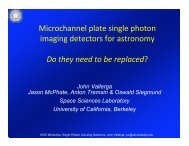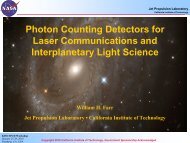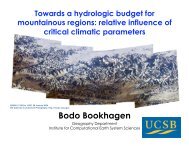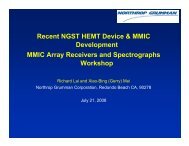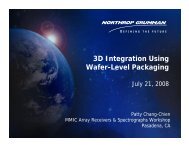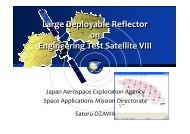Novel Nano Novel Nano-Engineered Semiconductors for ... - Caltech
Novel Nano Novel Nano-Engineered Semiconductors for ... - Caltech
Novel Nano Novel Nano-Engineered Semiconductors for ... - Caltech
Create successful ePaper yourself
Turn your PDF publications into a flip-book with our unique Google optimized e-Paper software.
<strong>Novel</strong> <strong>Nano</strong>-<strong>Engineered</strong> <strong>Semiconductors</strong> <strong>for</strong> PossiblePhoton Sources and DetectorsNAI-CHANG YEHDepartment of Physics, Cali<strong>for</strong>nia Institute of Technology1. <strong>Nano</strong>technology & nanomaterials-- Functional nanomaterials enabled by nanotechnologies.2. Semiconducting nanowires-- Why semiconducting nanowires? (Physics, applications & fabrication)-- Fabrication of NWs.-- <strong>Novel</strong> properties of strained silicon nano-pillar arrays (2 ~ 5 nmdiameters) & FET’s and quantum dots based on Si nano-pillars.3. Graphene nanoribbons & related nanostructures-- The rise of graphene.-- Physics of graphene.-- <strong>Novel</strong> phenomena of graphene & related structures.-- Potential applications to light emission & photodetection.
* In collaboration withM.L. Teague, C. R. Hughes, A.D. Beyer, A. P. Lai, T.-P. PW Wu (<strong>Caltech</strong>)Prof. A. Scherer & group members ------------------------------- (<strong>Caltech</strong>)Prof. M.W. Bockrath & Prof. C.-N. Lau ------------------- (UC Riverside)* Funding agenciesNational Science Foundation, Moore Foundation, andKavli Foundation --------------------------------------- (<strong>Caltech</strong>)National Science Foundation ------------------------------- (UC Riverside)
1. <strong>Nano</strong>technology & nanomaterials-- Functional nanomaterials enabled by nanotechnologies.2. Semiconducting nanowires (NWs)3. Graphene nanoribbons & other related nanostructures
1. <strong>Nano</strong>technologies & <strong>Nano</strong>materials• <strong>Nano</strong>technologies have enabled uniquely functionalized or structurednano-materials (“meta-materials”) <strong>for</strong>: studies of low-dimensional physics in quantum confinement; applications “from A to B” (astronomy, biology, beyond CMOS, etc.)• Reduced dimensionalities:Two-dimensionalOne-dimensionalZero-dimensional(graphene, 2DEG)(nanowires, nanotubes) (quantum dots, nanocrystals)http://www.ece.mcgill.ca/~ts7kop/images/graphene_xyz.jpgV. G. Dubrovskiia et al.,<strong>Semiconductors</strong> 43, (2009)L. Kouwenhoven et al.,Phys. World (2001)
1. <strong>Nano</strong>technology & nanomaterials2. Semiconducting nanowires-- Why semiconducting nanowires? (Physics, applications & fabrication)-- Fabrication of NWs.-- <strong>Novel</strong> properties of strained silicon nano-pillar arrays (2 ~ 5 nmdiameters) & FET’s and quantum dots based on silicon nano-pillars.3. Graphene nanoribbons & related nanostructures
2. Semiconducting <strong>Nano</strong>wires (NWs)21 2.1. Why semiconducting NWs?• Semiconducting nanowires (NWs) have been demonstrated to be highly versatileoptoelectronic components <strong>for</strong> a wide variety of applications, including:* polarization-sensitive photodetectors & arrays with sub-wavelength resolution;* polarization-sensitive nano-APD (with gains up to 10 5 );* optical modulators & nano-waveguides;* nano-LEDs and nano-lasers ;* solar cells, biomedical sensors, etc.Bulk Ge10 nm25 nm110 nmGermaniumnanowireL. Y. Cao et al. (2009)
Polarization-sensitive & spatially resolved nano-APDsp-type Si-NW&n-type CdS-NWp-Sin-CdS10 mGain up to 10 5V b = 10V = 488 nm No crosstalkSpatial resolutionbetter than 250nmPolarization-sensitiveHayden et al.Nature Mat.5, 352 (2006)
2.2. Fabrication of NWs• Mechanism of the growth vapor-liquid-crystal:id lV. G. Dubrovskiia etal.,<strong>Semiconductors</strong> 43, (2009)An ensembleof GaAs-NWsgrown by MBEAn individualGaAs-NW
• Formation of NWs by selective epitaxy on treated surfaces w/o a catalyst:V. G. Dubrovskiia etal., <strong>Semiconductors</strong>43, (2009)GaAs-NWsGaAs-NWsgrown on thegrown on theGaAs (111)GaAs (111)surface <strong>for</strong>surface <strong>for</strong>d 0 = 200 nmd 0 = 50 nm• Other growth mechanisms such as self-assembly, etc.
2.3. Strained silicon nano-pillars(Axel Scherer’s group)When small silicon pillars areoxidized, the silicon lattice expandsby approximately 40%, whichleaves the adjacent un-oxidizedsilicon under tremendous tensilestrain. In nanowires, this strain canincrease to the point where thesilicon oxidation process is selflimited,leaving stable 2 ~ 10 nmwide tensile-strained silicon coreswithin a silicon dioxide shells.The nano-pillar diameter is controlledby the oxidization temperature. t
Atomically resolved imaging & spectroscopy usingscanning tunneling microscopy (STM)STM operation is based on:1) Quantum tunneling of electrons-- Tunneling current (I) depends stronglyon the surface work function ( ), theseparation (s) and the biased voltage(V) between the tip & sample.2) Piezoelectric control-- Enables atomic scale resolution <strong>for</strong>surface topography and lateral scanningcapabilities.iTwo primary modes of operation:1) Three-dimensional imaging-- Under feedback control, the “constantcurrent map”.2) Spectroscopy-- Fixed location differential conductance(dI/dV)-vs.-V map, under constant .Tunnelingcurrent (I)Two mode ofoperation:1) imaging,2) spectroscopy.NbSe 2Electronstunnelacrossvacuum
Strain-enhanced energy gap in silicon nano-pillarsSpatially resolved spectroscopy ofHF-etched silicon nano-pillarsSurface topography from STMafter HF chemical etching3 eV250 nmThe energy gap increases from ~ 1.11 eV<strong>for</strong> crystalline silicon to ~ 3.o eV <strong>for</strong> thestrained silicon nano-pillars.(Our preliminary STM results)Further quantum confinement isexpected <strong>for</strong> a finite magnetic fieldparallel to the silicon nano-pillars,because the diameter of the nanopillarsis typically smaller than thecyclotron orbit.
Making a transistor out of a strained silicon nano-pillar:(Courtesy of Axel Scherer)
Similar transistor structures have been demonstrated inInAs nanowires with larger diameters and separations:V G Dubrovskiia etalV. G. Dubrovskiia et al.,<strong>Semiconductors</strong> 43, (2009)
1. <strong>Nano</strong>technology & nanomaterials2. Semiconducting nanowires3. Graphene nanoribbons & related nanostructurest-- The rise of graphene.-- Physics of graphene.-- <strong>Novel</strong> phenomena of graphene and related structures.-- Potential applications to light emission & photodetection.
3. Graphene <strong>Nano</strong>ribbons & Related <strong>Nano</strong>structures31 3.1. The Rise of GrapheneCarbon structures in different dimensions:0D 1D 2D 3D• Graphene consists of carbon atoms in honeycomb lattice.• Unique Dispersion Relations: massless Dirac Fermions.• First experimental isolationby Geim’s group in 2004.[Novoselov et al, Science (2005).]Two sublattices in thehoneycomb lattice:(Courtesy of M.W. Bockrath)EnergySingle layer Bilayerk
3.2. Physics of grapheneElectronic bandstructuresbandstructures of graphene:• Tight binding approximation, assuming a perfectly ordered infinitesystem, 3 covalently bonded sp 2 and 1 2p z conduction electrons.• The resulting E 2D (k) band structure isNear the “Diracpoints” K & K'3kakaykax 2 yE 2 D( kx, ky) 3 14cos cos 4cos ( eV)vf k2 2 2Images: Ph.D. thesis of Jinseong Heo, <strong>Caltech</strong> (2008).Image from:http://www.ece.mcgill.ca/~ts7kop/images/graphene_xyz.jpg
Graphene bipolar field effect transistors (FETs)Hole dopedElectron dopedDiracpointEFE FE FThe unique bandstructuresof graphene suppress carrierbackscattering, leading toextremely high mobility.• Conductivity ( ) increases linearly with charge density (n): V g n• Extremely high mobility: ~ 15,000 cm 2 /Vs in as-prepared, non-optimized samples,compared to ~ 2,000 cm 2 /Vs <strong>for</strong> silicon.• Conductivity remains finite at Dirac point min(Novoselov et al, Nature, 2005, Zhang et al, Nature 2005, Miao et al, Science 2007, Kimgroup, Fuhrer group….)
Challenges & Current Research DIrections• Large-scale & high-quality production MBE or CVD growth.• Device and bandgap engineering graphane (i.e. hydrogenated graphene) nanoribbons atomic switches local strainGraphane(0 ~ 3.5 eV)Graphene is a semi-metal,or zero-gap semiconductor.How does one engineer anenergy gap in graphenebasedsystems?• <strong>Novel</strong> devices ballistic transistors supercollimators & electronic lensing Schottky diodes & light emitting diodes photodectorsGraphene nanoribbon( 0 ~ 200 meV)
• Strain-induced induced modifications to the electronic propertiesof graphene:1. Mechanically exfoliated graphene on SiO2.2. CVD-grown graphene on Cu.
STM calibration on graphite• We tested on graphite tocalibrate STM and verify tipquality.• STM topography scan overgraphite manifests the A-B-A-B stacking of graphenehexagon sheets, known asthe Bernal stacking.
STM studies of graphene on SiO 2• STM topographic image of graphene reveals a distorted honeycomblattice, showing surface corrugations (~ 0.7 nm z-axis modulationsover ~ 20 nm distance) correlated with the underlying SiO 2 substrate.
STM studies of graphene on SiO 2• Fourier trans<strong>for</strong>m ofthe topographic imageof graphene reveals astrained-induceddistorted reciprocallattice.• Local electronicproperties are alsomodified by the strainfields.
Strained-induced induced conductance modulations• Constant-V B conductance maps at smallV B values correlate with overall surfacecorrugation and the resulting strain fields.Topography V B = 0• Maps of strain tensor components:S 00V B = 80 meV V B = 240 meVS 00S xxS xx (x,y) = u x (x,y)/xS yy (x,y) = u y (x,y)/yS xy (x,y) = S xy (x,y)= [u x (x,y)/y +u y (x,y)/x]/2Displacement field:u(x,y) = [u x (x,y) e x +u y (x,y) e y ]S xyS yy
Strain-induced induced modifications in the out-ofof-plane phonon-assisted tunneling gaps & conductanceT = 0Theoreticalcurve with ph= 42 meVThis work:M.L. Teague et al, <strong>Nano</strong>Letters 9, 2542 (2009)T = 0Theoreticalcurve with ph = 24 meVReferences:• Y. Zhang et al, Nature ph variesPhys. 4 (2008). from 21 meV• T.O. Wehling et al,to 44 meV.PRL 101 (2008).
The out-of-plane phonon frequencies increase with increasingstrain, suggesting coupling of -electrons to the underlyingphonons of the dielectric SiO 2 .N.-C. Yeh et al, preprint, (2010).
Strain-induced induced structural & conductance modificationsin large-scale CVD grown graphene on copper• CVD growth of graphene on copper foils at ~ 1000°C under hydrogen gas withCH 4 partial pressure.• Large differences in the thermal contraction coefficients of graphene and copperlead to ripple structures. [ N.-C. Yeh et al, (2010) ]
Modifications to electronic properties due to structural changesTopography(distortedstructure)t Fouriertrans<strong>for</strong>medstructuretN.-C. Yeh etal, (2010).Conductancespectra ofrepresentativeregionsabConductancespectra alongthe dashedline in theupper leftfigure.
3.4. Potential applications to light emission & photodetection• Graphene nanoribbons: semiconducting energy gaps may be engineeredby the controlling the width, from 0 ~ 200 meV.• Graphane: semiconducting energy gaps may be engineered by controllingthe hydrogen coverage, from 0 ~ 3.5 eV.Device conceptLight emissionThe light emittingprocess may bereversed <strong>for</strong> thedetection ofphotocurrents.t(or graphenenanoribbons)• Future work: measurements of the I-V characteristics & photocurrents.
Summary• <strong>Novel</strong> nanostructures such as strained silicon nano-pillars, semiconductingnanowires and graphene-based nano-devices may be interestingcandidates <strong>for</strong> new types of ultra-high-density ultra-compact sensitivephotodetectors, possibly even single-photon-counting detectors.10 m



